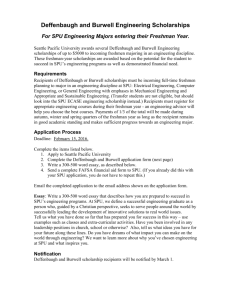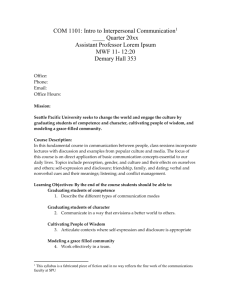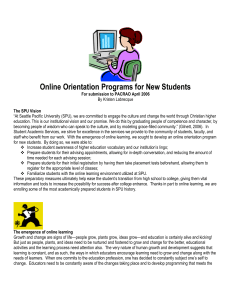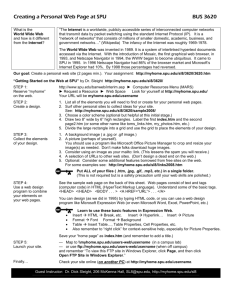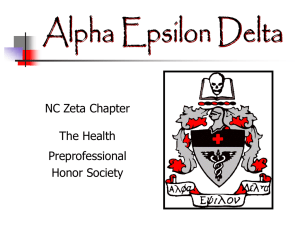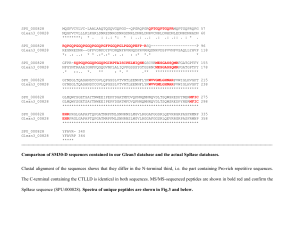(or Pre-Tenure) Review
advertisement
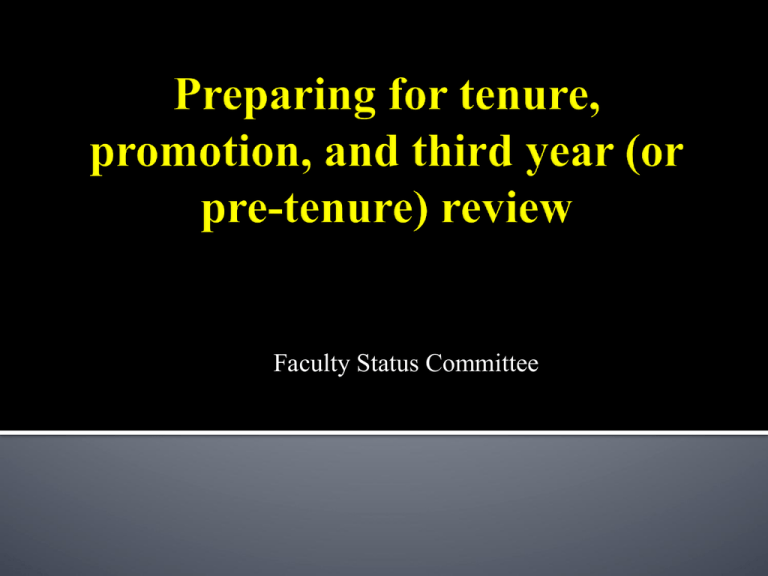
Faculty Status Committee Refer to the Handbook Section 5.2 Criteria for Evaluating Teaching Faculty Section 5.3 Evaluating Librarians Sections 5.5.3 and 5.5.4 Third Year Reviews Section 6.3 Criteria for Promotion Section 6.4 Procedure for Promotion Section 7.3 Criteria for Tenure Section 7.4 Procedure for Tenure Handbook takes precedence over anything folks tell you! The Faculty Handbook is available online via OAA You are building a case for yourself. You can’t build a case without documentary evidence. A file full of documents does not constitute a case. You must provide your readers (School or Departmental Review Committee, Dean, FSC, Provost, & President) with short narratives interpreting the meaning and significance of the documents in your file. Organized, clear and professional. A persuasive case is marked by the following characteristics: A clear statement of challenging-but-feasible and measurable goals in all areas. Evidence of critical reflection on your progress toward those goals (not necessarily that you have reached them all). Evidence of the concrete steps you have taken to achieve them. 1. Character and Congruence 2. Teaching and Advising 3. Research and Scholarship 4. Service to University, Guild, Church, and Community All file types are organized the same Part I: Primary documents 1. Preliminary Materials [no limit] 2. Curriculum vitae [5 pages] 3. Faith statement [4 pages] 4. Vocation narrative [4 pages] 5. Teaching self evaluation [4 pages] 6. Scholarly trajectory [2 pages] 7. Service [2 pages] 8. Advising [2 pages] Part II: Appendix – no page limits A. Current and prior PDP w/ responses B. C. D. E. F. Representative syllabi [4 minimum] Unabridged official university student evaluations ▪ Pre-tenure: All since arrival at SPU ▪ Tenure: prior three years minimum ▪ Promotion: prior three years minimum Peer assessment of teaching Scholarly products Other supporting documents Preliminary materials: Table of Contents – active links to key sections Letters: Candidate: stating eligibility Department Chair (possibly added later) Departmental or School Committee Review (added later) Dean (added later) Faculty Status Committee (added later) Provost (added later) For Tenure: ▪ Third-year review FSC letter ▪ School Third-Year Review Committee report Curriculum Vitae [5 pages] Make sure to include dates of hire and past promotion. Separate out peer-reviewed publications from non-peer- reviewed. Do not include works in preparation (trajectory) List conference presentations and distinct works in separate categories. Faith statement [4 pages] 1. Statement of what you believe …affirmation of the central claims of historic Christian teaching… Responsive to the SPU Statement of Faith http://www.spu.edu/info/statement-of-faith.asp) historically orthodox … clearly evangelical … distinctly Wesleyan … genuinely ecumenical ( Faith statement [4 pages] 2. Description of your “faith journey” “a narrative that describes the development of the candidate’s faith over the years” 3. Description of spiritual disciplines “the current practices that form and sustain the candidate’s faith and life” Discussion of church participation Vocation narrative [4 pages] Connection between faith and… Scholarship Teaching Service How do your convictions affect your work in each of these three areas? What is your philosophy of Christian higher education? Teaching Self-evaluation [4 pages] Note range of courses taught at SPU Summary of Student Course Evaluations in the form of a chart or table Interact with both student and peer evaluations Self-analysis of strengths and weaknesses Select three to four key areas, describe your response and note results Scholarly trajectory [2 pages] Quote relevant passages from your school or departmental scholarship standard; then show how you’ve met that standard. Note Peer-reviewed publications or equivalents Provide some description of the journal (e.g., acceptance rate) or other indicator of quality. (appendix) If ‘forthcoming’ or ‘submitted’ provide evidence that the work has been accepted for publication. Works in preparation can serve as evidence of your research trajectory. Presentations at Conferences, leadership Roles in Professional Organizations Service [2 pages] Service to University Committees or Task Forces Other cross-campus service (e.g., interview committees, Day of Common Learning, etc.) Participation in “extra” events (e.g., “Meet the Professor” day, Majors’ Fair, New Student Advising, etc.) Departmental committee work Service to Students (cadres, clubs, etc.) Briefly indicate the nature of your involvement and time commitment. Mentoring untenured faculty Service in professional guilds Service in church, community organizations or governmental agencies Advising [2 pages] What is your role as an advisor? Specific qualifications and skills Number of advisees Self-assessment of effectiveness A. Past and current Professional Development Plan with responses. Include Chair or Dean’s response. B. Representative syllabi [4 required] C. Official university student evaluations – unabridged D. Peer review of teaching One inside and one outside school or department Do not include letters from your mentor Representative scholarly products E. reprints of journal articles and/or copies of grant proposals Include artistic works, other scholarly activities as appropriate and defined by Scholarship Standards Include short description of the type of scholarship Note the role of peer review, impact factor Do not include books in their entirety. (Instead, you might scan the title page and table of contents.) F. Additional supporting documents Promotion to Full Professor: At least 2 letters of support evaluating your scholarship and impact from peers outside the University. Solicited by Deans. Other letters that attest to character, congruence, competence or contribution CSFD website has a description of how to prepare a good letter: Special Considerations for Tenure Mission Fit Trajectory: Where are you headed with your research/scholarship? Note: Re letters of recommendation, if you are planning to go up for tenure and also promotion (in the following quarter), be sure the letter-writers indicate support for both. Special Considerations for Promotion Promotion: the emphasis is on what you’ve accomplished. Section 6.3 spells out specific promotion-related requirements. Different standards for promotion to Associate Professor and promotion to Professor: To Associate: Good in all areas, emerging strength in one. To Professor: Strong in all areas, excellent in one. See Handbook for Details General Process Submit files to department or school ▪ Deadlines: http://www.spu.edu/depts/oaa/ Departmental or School Committee Review Dean’s Review Faculty Status Committee Review (3rd year review mostly stops here) Provost Review President’s Review Board of Trustees (tenure only) 1. 2. 3. 4. 5. 6. 7. 8. 9. 10. Make sure the file is organized, clear and professional. Avoid “fluff” (e.g., thank you notes from students) Do not assume reviewers know you (and/or your program). Be clear about dates (e.g., of last promotion, publications). Be clear about which works are peer reviewed. Provide unabridged course evaluations. Your file must be electronic and indexed. Ask status members for help prior to submission Only contact status members through Dean post submission Do not include letters from your assigned mentor Your file must ultimately be electronic. Two ways to “go electronic”: 1. Construct an “all paper” file, and have it scanned. (Very important that it be ready to “put in the hopper,” e.g., no paper clips, no staples.) Key contact person: Janiess Sallee, Instructional Technology services. 2. Use Adobe Pro to create your own electronic file. (You may have to have some non-electronic documents scanned and added to the file.) To Install Adobe Acrobat Professional: contact Computer & Information Systems at help@spu.edu or 206.281.2982 for assistance with installing the latest version of this software on your work computer. 1. Electronic files should be clearly indexed 2. Include clear section separations 1. Include in text links to key letters or data from appendices Teaching Self-evaluation [4 pages] Peer Evaluation of teaching ▪ “at least one by a member of the candidate’s school or department and one by a peer from outside of the candidate’s school or department ” ▪ Include one from outside your discipline if in a professional school ▪ Mentors are precluded by handbook from providing a letter to candidate Installing Adobe Acrobat Professional Please contact Computer & Information Systems at help@spu.edu or 206.281.2982 for assistance with installing the latest version of this software on your work computer. Converting a Microsoft Word 2010 (PC) or Word 2011 (Mac) document to a PDF Faculty may obtain the latest version of Microsoft Office for either PC or Mac from Computer & Information Systems. To learn more, visit http://www.spu.edu/cishelpdesk/software/license/ or contact CIS at help@spu.edu or 206.281.2982. There are a variety of ways to generate a PDF file from a Word document. A simple way to do so is the following: Open your document in Microsoft Word. Click File > Save As. Set the Save as Type to be PDF. Name the file, select where you would like it to be saved, and click Save. Combining Multiple PDFs into a Single PDF Using Adobe Acrobat X Pro Open Adobe Acrobat X Pro. Click Create > Combine Files into a Single PDF. Drag and drop the files you want to combine into the window that appears. Click and drag the files to arrange them in the order in which you would like them to appear in the combined PDF. Click Combine Files to finish the process.
